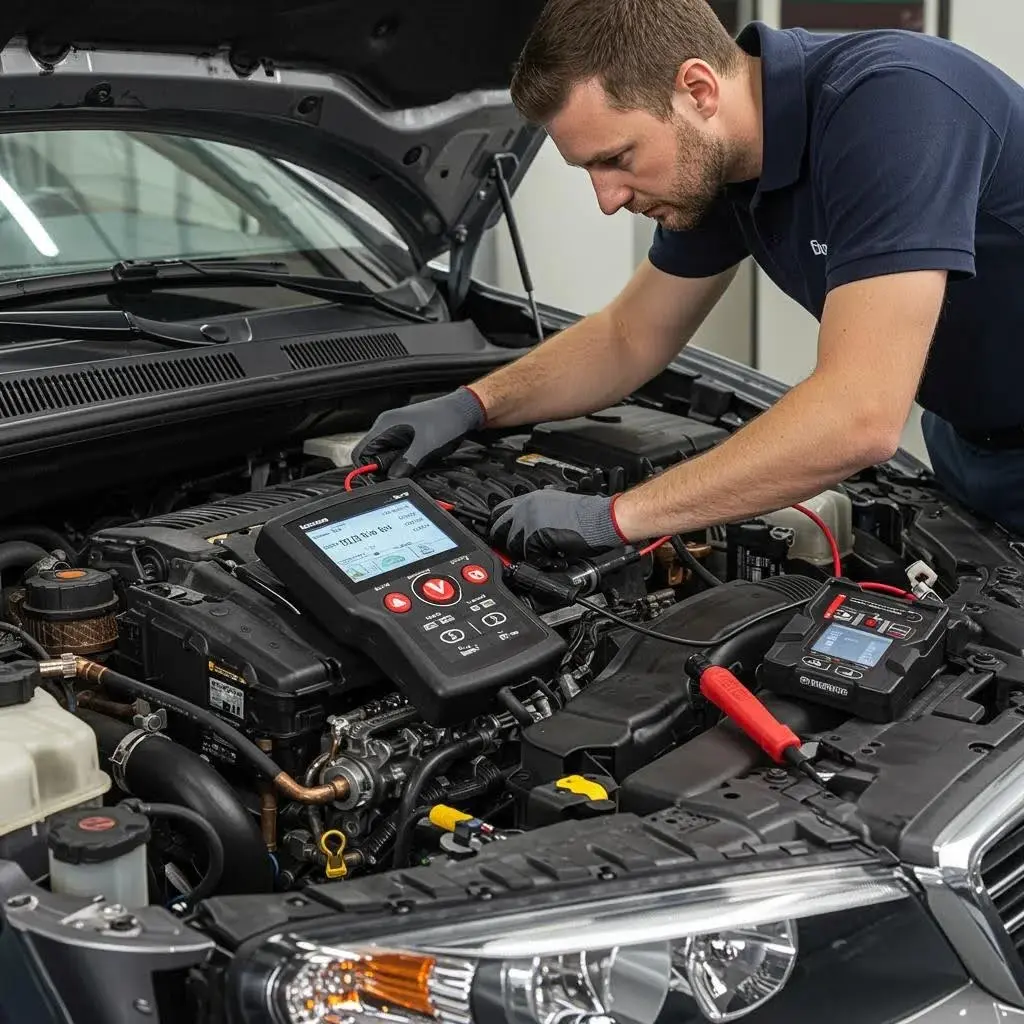
Your car’s air conditioning keeps you comfortable by delivering cool air on hot days. However, when it blows warm air, that signals an issue that can quickly turn a pleasant drive into discomfort. With warmer UK summers, a fully functioning AC is essential.
This guide covers five common causes of warm air, low refrigerant, compressor failure, condenser problems, blend door actuator faults, and electrical issues.
We outline key symptoms, causes, diagnostic steps, and fixes. You’ll see how to spot warning signs, why each component matters, and how Sovereign Motor Engineers’ Air Conditioning System Service in Tonbridge restores cooling for daily drivers and classic cars.
Key Signs Your Car AC Isn’t Blowing Cold

When your car’s AC underperforms, watch for warm air from the vents, inconsistent cabin temperatures, unusual noises, unpleasant odours, or visible leaks around AC components. Spotting these early helps prevent minor issues from becoming costly repairs.
Before the causes, here’s a quick rundown of common symptoms:
- Warm air blowing from the vents, even on the lowest temperature setting.
- Fluctuating cabin temperatures or inconsistent airflow.
- Strange hissing or rattling sounds when the AC is running.
- A sweet chemical smell or oily residue near AC hoses.
- The compressor clutch cycles too frequently.
Each sign points to a likely AC fault, prompting inspection of refrigerant level, compressor, condenser, blend door, and electrical connections.
How to Confirm Your Car AC Is Blowing Warm Air
The simplest confirmation is the temperature of the air from your vents. If refrigerant pressure is low or circulation is compromised, the evaporator can’t absorb cabin heat, so the system pushes ambient-temperature air regardless of fan speed or settings. Checking vent temperature is the first diagnostic step.
Signs of Low Refrigerant in Car AC
With low refrigerant, cooling gradually weakens. The air isn’t as cold, and the system runs longer to drop the temperature. Faint hissing can signal a leak. You may notice a sweet odour and oily stains around service ports or hose connections.
Impact of a Faulty AC Compressor on Cooling
The AC compressor circulates refrigerant and maintains system pressure. If it fails, refrigerant flow drops and cooling suffers. Loud grinding or knocking, or an erratic clutch, are common signs. In severe cases, a seized compressor stops cooling entirely.
Indicators of a Bad AC Condenser
The front-mounted condenser dissipates heat from the refrigerant. If debris blocks it or fins are damaged, it can’t release heat efficiently, reducing cooling and potentially raising engine temperature. Cooling often struggles at low speeds; a visual check may show debris or bent fins.
Blend Door Actuator Problems and AC Temperature Control
A blend door actuator moves the flap that mixes hot air from the heater core with cold air from the evaporator. If the motor or linkage fails, the door can stick or move erratically, causing unpredictable temperature changes, hot blasts one moment, lukewarm the next, even without adjusting controls.
This often points to an internal air-mix issue, not refrigerant or compressor faults.
Refrigerant Leaks and Warm Car AC
A refrigerant leak is a common reason for warm air. Refrigerant circulates to absorb cabin heat and release it outside. When it leaks, the system charge and pressure drop, reducing heat absorption. The evaporator then can’t cool the air effectively, so warm air reaches the vents.
Before diagnosis and repair, here’s a quick reference table:
| Component | Attribute | Evidence |
|---|---|---|
| Refrigerant | Pressure loss | Cabin temperature rises quickly |
| Hose seals & O-rings | Material wear | Oily residue and hissing |
| Evaporator core | Tiny perforations | Excess moisture inside the car; potential mould growth |
| Condenser connections | Corrosion or damage | Damp patches near the front grille or radiator |
Understanding how leaks affect each component is crucial for accurate diagnosis and repair, ensuring your AC delivers efficient cooling again.
Refrigerant: Its Role in Car Cooling
Refrigerant is the primary cooling agent in your car’s AC. It changes phase, from low-pressure gas to high-pressure liquid and back, absorbing heat at the evaporator and releasing it at the condenser. This continuous heat exchange produces cold air.
Common Signs of a Car AC Refrigerant Leak
A leak often shows as weaker cooling. You might also hear hissing from AC lines, see oily residue at fittings, or detect a faint sweet smell inside the cabin, strong signs that refrigerant is escaping.
Causes of Refrigerant Leaks in Car AC Systems
Vibration and temperature swings wear hoses, seals, and O-rings, causing leaks. Corrosion, road debris, or damage to the condenser or evaporator can create holes or cracks that let refrigerant escape.
Sovereign Motor Engineers: Diagnosing and Fixing Refrigerant Leaks in Tonbridge

At Sovereign Motor Engineers, we use thorough leak detection to pinpoint refrigerant leaks. Our Air Conditioning System Service seals leaks or replaces faulty parts, then evacuates and recharges to the correct level, restoring optimal performance.
AC Compressor Failure and Warm Air
The compressor circulates refrigerant and maintains pressure. When it fails, due to worn parts or a faulty clutch, flow stops, the evaporator can’t absorb heat, and warm air reaches the vents. Running with low refrigerant accelerates wear and contamination. Prompt repairs prevent larger failures.
Role of the AC Compressor in Cooling
The compressor is the system’s pump. It compresses low-pressure refrigerant gas into high-pressure, high-temperature gas so it can release heat at the condenser and absorb heat at the evaporator, driving the cooling cycle.
Common Signs of a Failing AC Compressor
Noise is often the first clue. Listen for loud rattling, grinding, or distinct clicking with the AC on. You may also see the clutch rapid-cycle, or the engine struggle under load as the compressor works harder.
Causes of AC Compressor Problems
Low lubrication (often from low refrigerant) causes internal wear. Bearings can degrade, clutches misalign, and contaminants can enter the system, impairing compressor function and leading to overheating or failure.
SME: Repairing or Replacing a Faulty AC Compressor
Our technicians inspect the compressor, test clutch engagement, and measure output pressure. If repairable, we replace worn seals and bearings; if not, we fit a compatible replacement. After repairs, we evacuate and recharge with the correct refrigerant to ensure reliable, long-lasting cooling.
Symptoms and Causes of a Faulty AC Condenser
The condenser releases cabin heat to the outside air. If fins clog with dirt or debris, or are damaged, airflow drops, and refrigerant can’t cool effectively, reducing AC performance. You may notice slower cooling, especially when stationary, and rising engine temperature at low speeds.
Ignoring a faulty condenser can lead to increased pressure within the AC system, putting excessive strain on the compressor and potentially causing more serious damage.
How the AC Condenser Works in Your Car’s Cooling System
At the front of the vehicle, the condenser receives hot, high-pressure refrigerant gas from the compressor. Airflow through its fins (and the cooling fan) removes heat, condensing the refrigerant into a high-pressure liquid before it moves to the next component.
Key Symptoms of a Damaged or Blocked AC Condenser
Reduced cooling is the primary symptom. Engine temperature may rise at idle or low speed. The cooling fan may run more often or noisily. A visual check can reveal bent fins, debris blockages, or oily spots indicating a leak.
Common Issues Leading to AC Condenser Failure
Physical damage from road debris (stones or grit) can bend or puncture fins. Road salt accelerates corrosion. Low-speed impacts or parking knocks can also damage the condenser. Blocked fins restrict airflow, causing high-pressure build-up that may crack the unit.
SME: Diagnosing and Repairing AC Condenser Problems in Tonbridge
We start with a visual inspection for damage or blockages, then run pressure tests for internal leaks. If blocked, we clean the fins and remove debris; if damaged or leaking, we replace the condenser. After repairs, the system is evacuated, leak-tested, and recharged for optimal flow and cooling.
Blend Door Actuator Issues and Temperature Control
The blend door actuator controls cabin temperature by directing airflow through the heater core, evaporator, or both. If it fails, the door may stick, causing sudden hot-to-cold shifts or unresponsive temperature control, even with the fan running.
Often, a failing blend door actuator will make clicking or grinding noises behind the dashboard as its internal gears wear out or the motor struggles to move the door.
Blend Door Actuator: Function
The blend door actuator is an electric motor that moves a flap inside the HVAC system. It regulates how hot and cold air mix to reach your selected temperature.
Signs of a Faulty Blend Door Actuator
Listen for clicking, popping, or grinding behind the dashboard, often when you adjust the temperature. You may also see inconsistent cabin temperatures or no response to temperature settings.
Causes of Blend Door Actuator Failures
The most common cause is worn plastic gears that strip or break, stopping the motor from moving the door. Corroded contacts or damaged linkage can also cause failure, especially in older or high-mileage vehicles.
SME: Fixing Blend Door Actuator Issues for Consistent Cooling
To fix a faulty actuator, our technicians access it by removing trim as needed, replacing the unit with a compatible part, calibrating it for the full range of motion, and testing the system under various settings before reassembling.
Diagnosing Electrical Faults That Cause Warm AC
Electrical faults are a significant cause of AC malfunctions. Issues with fuses, relays, wiring, or sensors can cut power to the compressor clutch or cooling fans. Because modern AC relies on networked signals, any break can stop cooling. Diagnosis means systematically testing each component to locate the fault and avoid unnecessary parts.
Electrical Components Affecting Car AC Performance
Key components include fuses and relays, temperature sensors (cabin and refrigerant), the blower motor resistor, and the wiring harnesses linking them to the control module.
Symptoms of Electrical Faults in Car AC Systems
Symptoms vary. You might see no AC operation, no compressor engagement, and no fan. Or the system may be intermittent, the fan speed erratic, or the display may show error codes. Sudden failures often point to an electrical issue.
SME: Diagnosing and Repairing Electrical AC Problems in Tonbridge
We use specialised tools, multimeters, and advanced scan tools to trace circuits. We verify voltage at the compressor clutch, test relays and fuses, and confirm sensor readings. Damaged wiring is repaired or replaced, and the climate control module is checked to restore full functionality.
Choosing Sovereign Motor Engineers for Car AC Repair in Tonbridge
Sovereign Motor Engineers offers local convenience, experienced technicians [replacing “award-winning” and tenure claims; Fact-check needed], and a comprehensive Air Conditioning Regas Service, from in-depth diagnostics and precise leak detection to refrigerant recharge and component repair or replacement, with transparent pricing.
Our technicians provide honest, upfront quotes, use quality parts, and maintain transparent processes. Our work focuses on careful workmanship and clear communication from start to finish.
SME’s Expertise for Classic and Vintage Car Owners
Classic car owners choose Sovereign Motor Engineers for specialised AC restoration and retrofit. Our technicians understand older HVAC systems, source compatible parts, and integrate modern refrigerant solutions. We help preserve originality while restoring modern comfort.
Booking Your Car AC Service with SME
Booking is simple. Call us or visit our Tonbridge garage to schedule. We’ll discuss options, explain diagnostic fees, and advise on turnaround, so you can get back to cool, comfortable drives.
People Also Ask: Common Questions About Car AC Not Blowing Cold
Reasons for Car AC Blowing Warm Air
Warm air usually points to low refrigerant, a faulty compressor, a blocked condenser, a blend door issue, or an electrical fault. Any of these disrupts heat exchange, preventing chilled refrigerant from cooling cabin air.
Signs of a Car AC Refrigerant Leak
Key indicators: weaker cooling, hissing near AC lines, oily residue at connections, and a faint sweet/chemical odour, suggesting refrigerant and oil are escaping.
Car AC Repair Cost in Tonbridge
Costs vary by fault and complexity. Refrigerant recharges are typically less than replacing seals or major components like the compressor or condenser. Sovereign Motor Engineers offers an initial diagnostic fee and clear pricing options for transparency.
Electrical Issues and AC Cooling Loss
A blown fuse or faulty relay can stop the compressor clutch or cabin fan from engaging, causing a complete loss of cooling. Intermittent cooling or a system that won’t turn on often indicates an electrical fault needing professional diagnosis.
Identifying a Faulty AC Compressor or Condenser
Listen for grinding or rattling with the AC on; often a compressor issue. Poor cooling despite a correct refrigerant level is another sign. Check for leaks or damage at the front (condenser) or under the bonnet (compressor). Pressure testing is the most reliable confirmation.
Your comfort depends on a properly functioning AC system, free from leaks, electrical faults, and mechanical wear. Recognise early signs, warm air, unusual noises, visible residue, and understand the roles of key components to act promptly.
Sovereign Motor Engineers in Tonbridge offers diagnostics, leak detection, recharging, and component repairs for daily drivers and classic cars, helping get your AC blowing cold again.



